
21 West Street, also known as Le Rivage Apartments, is a 33-story building located in the Financial District of Lower Manhattan in New York City, on Morris Street between West Street and Washington Street. It was built in 1929–1931 as a speculative office tower development in anticipation of an increased demand for office space in Lower Manhattan. The building was converted into apartments in 1997 and was renamed Le Rivage.

The Samuel J. Tilden House is a historic townhouse pair at 14-15 Gramercy Park South in Manhattan, New York City. Built in 1845, it was the home of Samuel J. Tilden (1814–1886), former governor of New York, a fierce opponent of the Tweed Ring and Tammany Hall, and the losing presidential candidate in the disputed 1876 election. Tilden lived in the brownstone from 1860 until his death in 1886. From 1881 to 1884, Calvert Vaux combined it with the row house next door, also built in 1845, to make the building that now stands, which has been described as "the height of Victorian Gothic in residential architecture" with Italian Renaissance style elements. Since 1906 it has been the headquarters of the National Arts Club, a private arts club.

The houses at 157–165 East 78th Street are a row of five attached brick houses on that street in Manhattan, New York, United States. They are the remainder of an original group of 11 built in 1861, when the area was originally being developed due to the extension of rail transit into it.
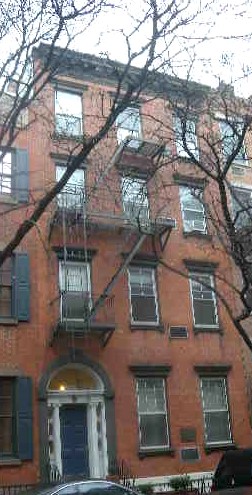
116 Sullivan Street is on Sullivan Street in SoHo, Manhattan, New York. The red four-story brick Federal townhouse was built in 1832 as an investment by Charles Starr (bookbinder) and includes some Greek Revival details. It was heightened two stories in 1872. The structure is noteworthy for its elaborated round-arched brownstone doorcase, or "enframement of the front door," which has an exceptional treatment of painted timber Ionic half-column sidelights, unique and highly significant in New York City architecture. Due to the sidelights, "instead of leaded glass, typical of the time, each sidelight is divided into three superimposed oval sections. The ovals are formed by a richly carved wood enframement that simulates a cloth sash curtain drawn through a series of rings."

The East 80th Street Houses are a group of four attached rowhouses on that street in the New York City borough of Manhattan. They are built of brick with various stone trims in different versions of the Colonial Revival architectural style.

The East 73rd Street Historic District is a block of that street on the Upper East Side of the New York City borough of Manhattan, on the south side of the street between Lexington and Third Avenues. It is a neighborhood of small rowhouses built from the mid-19th to early 20th centuries.

The Hotel Gerard, currently known as aka Times Square, is a historic hotel located in New York, New York. It had also operated at the Hotel Langwell and Hotel 1-2-3. The building was designed by George Keister and built in 1893. It is a 13-story, U-shaped, salmon colored brick and limestone building with German Renaissance style design elements. The front facade features bowed pairs of bay windows from the third to the sixth floor and the building is topped by steeply pointed front gables and a highly decorated dormer. It was originally built as an apartment hotel.

The Edward Mooney House is a building at 18 Bowery, at the corner of Pell Street, in the Chinatown neighborhood of Manhattan, New York City. It was built between 1785 and 1789 for wealthy butcher Edward Mooney on land he purchased after it was confiscated from British Loyalist James De Lancey.

The Stephen Van Rensselaer House at 149 Mulberry Street between Grand and Hester Streets in the Little Italy neighborhood of Manhattan, New York City, was built c.1816 in the Federal style by Stephen Van Rensselaer III. It was originally located on the northwest corner of Mulberry and Grand, but in 1841 was moved down the block to its current location. The two-story dormered house is typical of Federal-style row houses which were common at the time in Manhattan below 14th Street.
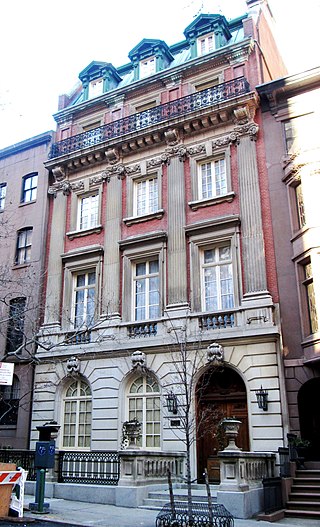
The James F. D. Lanier Residence, also known as the James F. D. and Harriet Lanier House is a historic house at 123 East 35th Street between Park and Lexington Avenues in the Murray Hill neighborhood of Manhattan, New York City.

The Century Building is a Queen Anne style building at 33 East 17th Street between Park Avenue South and Broadway in Union Square, Manhattan, New York City. It was designed by William Schickel and built in 1880–1881 by Arnold Constable & Company. The Century Building consists of five floors topped by a 1+1⁄2-story attic.

The Hamilton-Holly House, located at 4 St. Mark's Place in the East Village section of Manhattan, is a Federal style townhouse constructed in 1831. A designated landmark, it was the home of Eliza Hamilton, the widow of Alexander Hamilton, from 1833 to 1842. The Trash and Vaudeville fashion store was located there for over forty years ending in 2016.

The Sniffen Court Historic District is a small close-ended mews, running perpendicularly southwest from East 36th Street, between Third and Lexington Avenues in the Murray Hill neighborhood of Manhattan in New York City. The district, one of the smallest in New York City, encompasses the entire alley, which consists of 10 two-story brick stables built in 1863–1864 in the early Romanesque Revival style. The New York City Landmarks Preservation Commission designated Sniffen Court as a city historic district on June 21, 1966, and the district was added to the National Register of Historic Places on November 28, 1973.

The Norwood Club was a private members club located in the Chelsea neighborhood of Manhattan in New York City. It was founded in 2007 by Alan Linn and Steve Ruggi, who intended it to be a modern incarnation of the traditional gentlemen's club. Like the fine arts focused Century Association, the Norwood Club drew its membership from New York City's arts and creative community. Linn described the Norwood Club as a "club for the curious." The Norwood Club's members had reciprocity with other private clubs in London, Los Angeles, San Francisco, South Africa, Sydney, Paris, Dublin, Budapest, Toronto, Buenos Aires, and Shanghai.
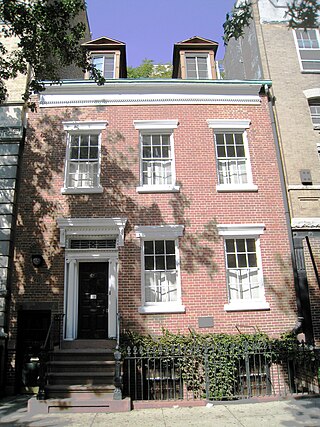
Charles Street is a street in the West Village neighborhood of Manhattan in New York City. It runs east to west from Greenwich Avenue to West Street. The street was named after Charles Christopher Amos, who owned the parcel the street passed through. Amos is also the namesake of Christopher Street, two blocks to the south, and the former Amos Street, which is now West 10th Street. Charles Lane is a one-block alley located between Charles and Perry Streets and Washington and West Streets. From 1866 to 1936, the section of Charles Street between Bleecker Street and West 4th Street was called Van Ness Place after a farm, owned by the Van Ness family, which had occupied the square bounded by Bleecker, West 4th, Charles and Perry Streets until 1865.

The Gideon Tucker House, also known as 2 White Street, is an historic house at the corner of West Broadway and White Street in the TriBeCa neighborhood of Manhattan, New York City.
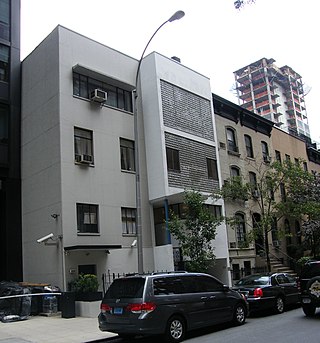
The Lescaze House is a four-story house at 211 East 48th Street in the East Midtown and Turtle Bay neighborhoods of Manhattan in New York City. It is along the northern sidewalk of 48th Street between Second Avenue and Third Avenue. The Lescaze House at 211 East 48th Street was designed by William Lescaze in the International Style between 1933 and 1934 as a renovation of a 19th-century brownstone townhouse. It is one of three houses in Manhattan designed by Lescaze.
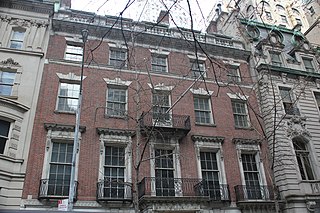
11 West 54th Street is a commercial building in the Midtown Manhattan neighborhood of New York City. It is along 54th Street's northern sidewalk between Fifth Avenue and Sixth Avenue. The four-and-a-half-story building was designed by McKim, Mead & White in the Georgian Revival style and was constructed between 1896 and 1898 as a private residence. It is one of five consecutive townhouses erected along the same city block during the 1890s, the others being 5, 7, 13 and 15 West 54th Street.
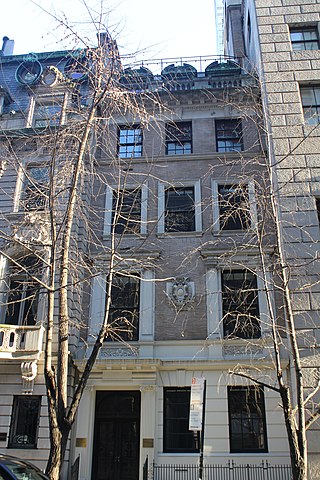
5 West 54th Street is a commercial building in the Midtown Manhattan neighborhood of New York City. It is along 54th Street's northern sidewalk between Fifth Avenue and Sixth Avenue. The four-story building was designed by R. H. Robertson in the Italian Renaissance Revival style and was constructed between 1897 and 1899 as a private residence. It is the easternmost of five consecutive townhouses erected along the same city block during the 1890s, the others being 7, 11, 13 and 15 West 54th Street. The first floor is clad with rusticated blocks of limestone, while the other floors contain buff-colored brick trimmed with limestone.
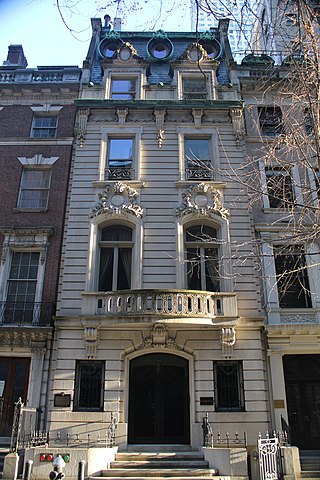
7 West 54th Street is a commercial building in the Midtown Manhattan neighborhood of New York City. It is along 54th Street's northern sidewalk between Fifth Avenue and Sixth Avenue. The four-story building was designed by John H. Duncan in the French Beaux-Arts style and was constructed between 1899 and 1900 as a private residence. It is one of five consecutive townhouses erected along the same city block during the 1890s, the others being 5, 11, and 13 and 15 West 54th Street.























